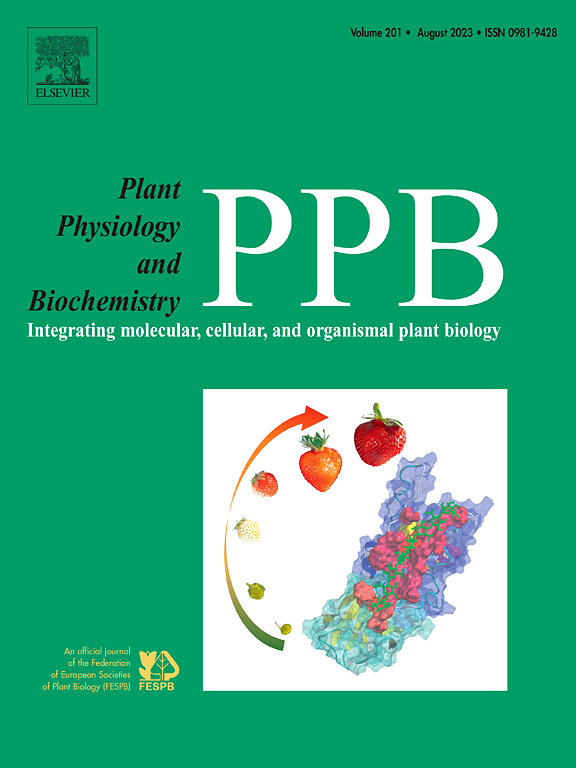综合营养元素、内源激素和转录组学分析,揭示云南松生长高度变化的影响因素
IF 6.1
2区 生物学
Q1 PLANT SCIENCES
引用次数: 0
摘要
云南松是中国西南地区重要的森林资源,对生态系统稳定性和生物多样性具有重要影响。生长高度的变化是树木发育的关键性状,影响产量和植株结构。了解这种变异可以提高森林生产力,提高造林成功率。尽管在云南云杉苗期观察到高度生长的实质性差异,但控制这种变化的分子机制尚不清楚。本研究以同质园林内1900余株云南云杉苗为研究对象,将其划分为3个等级(I >;二比;III)采用均值±1 / 2标准差法。目的是通过分析表型性状、营养元素、转录组学和内源植物激素,探讨快速生长期生长身高变化的机制。同质园林试验结果表明,云南云杉幼苗株高和地径的生长均呈s型生长规律。各器官平均氮磷比为3.97,说明氮是主要的生长限制因子,磷也有一定的限制作用。养分含量和化学计量比的变化对幼苗高度有显著影响。转录组学分析显示,在苯丙素和类黄酮生物合成以及植物激素信号转导等途径中显著富集。共鉴定出22种内源植物激素和代谢物。IAA(吲哚-3-乙酸)、GA7(赤霉素A7)和ABA(脱落酸)的水平依次为:I级;二级>;三级苗木。同时,还发现了几个参与植物激素信号转导的候选基因,包括GH3、CYCD3、GID1等。这些基因参与生长素、油菜素内酯和赤霉素的生物合成途径,表明它们在调节植物激素水平和幼苗高度生长中起作用。本研究为全面了解云南云杉幼苗生长高度的变化规律,为云南云杉幼苗的遗传改良和有效栽培奠定基础。本文章由计算机程序翻译,如有差异,请以英文原文为准。
Integrating analysis of nutrient elements, endogenous phytohormones, and transcriptomics reveals factors influencing variation of growth in height in Pinus yunnanensis Franch
Pinus yunnanensis Franch., a vital forest resource in southwestern China, significantly impacting ecosystem stability and biodiversity. Variation of growth in height, a crucial trait for tree development, affects both yield and plant structure. Understanding this variation can enhance forest productivity and improve afforestation success. Although substantial differences in height growth are observed during the seedling stage of P. yunnanensis, the molecular mechanisms governing this variation remain unclear. In this study, more than 1900 P. yunnanensis seedlings in a homogenous garden were classified into three grades (I > II > III) using the mean ± ½ standard deviation method. The aim was to investigate the mechanisms underlying variation of growth in height during the rapid growth phase by analyzing phenotypic traits, nutrient elements, transcriptomics, and endogenous phytohormones. Results from the homogenous garden experiment revealed that the plant height and ground diameter growth of P. yunnanensis seedlings exhibited an S-shaped growth rhythm. The average nitrogen-to-phosphorus (N:P) ratio across organs was 3.97, indicating that nitrogen is the primary growth-limiting factor, with phosphorus also contributing to the limitation. Variations in nutrient content and stoichiometric ratios were found to significantly influence seedling height. Transcriptomic analysis highlighted significant enrichment in pathways including phenylpropanoid and flavonoid biosynthesis, and plant hormone signal transduction. A total of 22 endogenous phytohormones and metabolites were identified. The levels of IAA (indole-3-acetic acid), GA7 (gibberellin A7), and ABA (abscisic acid) followed the pattern: Grade I > Grade II > Grade III seedlings. Simultaneously, several candidate genes involved in plant hormone signal transduction were identified, including GH3, CYCD3, GID1, and others. These genes are involved in the biosynthesis pathways of auxins, brassinosteroids, and gibberellins, suggesting their role in regulating phytohormone levels and seedling height growth. This study provides comprehensive insights into variation of growth in height, laying the foundation for genetic improvement and effective cultivation of P. yunnanensis seedlings.
求助全文
通过发布文献求助,成功后即可免费获取论文全文。
去求助
来源期刊
CiteScore
11.10
自引率
3.10%
发文量
410
审稿时长
33 days
期刊介绍:
Plant Physiology and Biochemistry publishes original theoretical, experimental and technical contributions in the various fields of plant physiology (biochemistry, physiology, structure, genetics, plant-microbe interactions, etc.) at diverse levels of integration (molecular, subcellular, cellular, organ, whole plant, environmental). Opinions expressed in the journal are the sole responsibility of the authors and publication does not imply the editors'' agreement.
Manuscripts describing molecular-genetic and/or gene expression data that are not integrated with biochemical analysis and/or actual measurements of plant physiological processes are not suitable for PPB. Also "Omics" studies (transcriptomics, proteomics, metabolomics, etc.) reporting descriptive analysis without an element of functional validation assays, will not be considered. Similarly, applied agronomic or phytochemical studies that generate no new, fundamental insights in plant physiological and/or biochemical processes are not suitable for publication in PPB.
Plant Physiology and Biochemistry publishes several types of articles: Reviews, Papers and Short Papers. Articles for Reviews are either invited by the editor or proposed by the authors for the editor''s prior agreement. Reviews should not exceed 40 typewritten pages and Short Papers no more than approximately 8 typewritten pages. The fundamental character of Plant Physiology and Biochemistry remains that of a journal for original results.

 求助内容:
求助内容: 应助结果提醒方式:
应助结果提醒方式:


